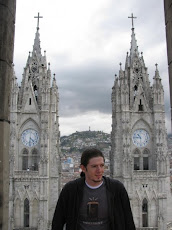In 1996, while on tour in Ecuador with the rock 'n roll band Beau Haddock and The Highland Rim, our group ended up in Ambato to headline the Fruit and Flower Festival there. Bands and dance troups from all over the world participate in this annual event. While there, we were invited to a private performance of the local university ballet group. Their dance was choreographed to Pink Floyd's The Wall. Ruthi commented on how beautiful the girls were, especially the lead dancer.
After the show, we were invited to a reception, where we met the dancers. To our dismay, we noticed that the prima ballerina had a huge cavity in her upper, front tooth, taking so much from her beauty, as well as,I am sure, from her self-esteem. As a dentist, I couldn't help but realize this lovely, talented young woman would most likely require an extraction within only a few months. Afterwards, Ruthi insisted we had to add a dental component to the volunteer work we had already been doing in Ecuador for nearly ten years.The big question was----What will we do, and how will we fund it?

For several years, we procrastinated because this would require a huge investment in time and money. In all my prior dental health projects (Haiti, Jamaica, Guatemala, Belize and Ecuador), I was unable to do anything but extractions, and could never come close to meeting the needs of the populace in these communities. It was frustrating to think I was doing nothing more than putting out fires. I came to realize more and more that prevention was the only true help, stopping the decay before it starts. So, in 2002, working directly with the Ecuador Minister of Health, we started a Sealant Project, where we provided the sealant material and training for government dentists in 15 clinics
in Ibarra and several surrounding communities, and 15 clinics in Quito.This was a partnership among the Minister of Health, the government dentists, the schools they supported, the parents, and Kentucky Ecuador Partners. Ruthi and I would provide the sealant material, and the government dentists would place them. The second year, on discovering that these children did not even have toothbrushes, we realized we sort of had the cart before the horse, so provided toothbrushes, which we obtained at a reduced rate from Darby Dental Spencer Meade, a dental supply house from whom we purchase our supplies for our own office.
In order to be successful, we realized we would need several components to this program. The dentists would place the material and every six months, under the pretense of checking to see that the sealants were still in place, they would see the kids back in their offices, clean and check their teeth and add fluoride into the process at the same time. The principals of the schools instituted a daily brushing program and included a dental health education program into their curriculum. Then, both the dentists and the schools began educating the parents. Most of the parents were subsistence farmers, with little or no education ,but loved their children just as we love ours, and wanted to help the kids in whatever ways they could. During the last year of this program, a new product for preventive dentistry entered the market. It was a new fluoride varnish with ACP (Amorphous Calcium Phosphate), manufactured by Premier Dental. This was destined to become one of the best preventive dental materials to ever enter the market. The ACP, when added to the Fluoride Varnish, causes the teeth to absorb 200% more fluoride than a regular fluoride treatment.



































